|
by Stephen Smith from Thunderbolts Website
Credit: ESO/Digitized
Sky Survey 2 According to a recent press release, astronomers have found,
By examining the positions of dwarf
galaxies and globular clusters around our galaxy, astronomers found
that they are not randomly distributed, but follow what is called “the
Plane of Satellites”.
Observations of the Plane of Satellites
calls the theory into question, however.
This circuit is driven by
Birkeland currents that connect the
galaxy with the rest of the Universe. Presumably, billion-light-year
long magnetically confined electric filaments transmit power from
one end of space to the other.
The Sloan Digital Sky Survey has
uncovered such a ring surrounding
the galaxy at a reported distance of 120,000 light years. This ring around the Milky Way Galaxy discovered by the Sloan Digital Sky Survey may be what's left of a collision between our Galaxy and a smaller, dwarf galaxy that occurred billions of years ago. It's an indication that at least part of our galaxy was formed by a lot of smaller or dwarf galaxies mixing together, explained investigators Heidi Jo Newberg of Rensselaer Polytechnic Institute and Brian Yanny of the Fermi National Accelerator Laboratory's Experimental Astrophysics Group. CREDIT: Rensselaer Polytechnic Institute and the Sloan Digital Sky Survey (www.sdss.org)
Since dwarf galaxies and globular clusters revolve in the galactic plane along with the ring, logic suggests that one force is acting on both.
Electromagnetism causes them all to be
aligned at right angles to the axial intergalactic magnetic field,
not gravity. Conventional viewpoints acknowledge that galaxies form
clusters, but it was not until recently that data analysis pointed
to those clusters grouping together along vast filaments of “hot
gas” that are more than a million degrees Celsius.
When we acknowledge that redshift is more a measure of youth than the distance of quasars, there is a possibility that the visible Universe is formed from braided filaments passing through the Virgo supercluster to the Fornax supercluster across millions of light years.
|


